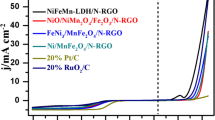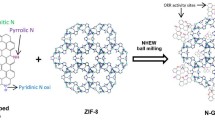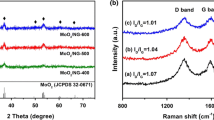Abstract
Molybdenum carbide/molybdenum nitride hybrid N-doped graphene (abbreviated as Mo2C/MoN/NG), as an efficient electrocatalyst for the hydrogen evolution reaction (HER), was synthesized via simple ion-exchange resin synthesis followed by a two-step annealing process, which increased the dispersion degree of the electrocatalyst’s active sites on the support skeleton and simplified the synthetic conditions. Additionally, N-doped graphene (NG) enhanced the electron transfer and reduced the inner resistance. The material has a graphene-like morphology and highly dispersed Mo2C/MoN nanoparticles about 2 nm in diameter on the NG. X-ray photoelectron spectroscopy, X-ray diffraction, and high-resolution transmission electron microscopy revealed that Mo2C/MoN/NG consisted of Mo2C and MoN composited together. Finally, Mo2C/MoN/NG exhibited remarkable performance as an electrocatalyst for the HER with a small overpotential of 78.82 mV and a small Tafel slope of 39.3 mV·dec−1 in a 0.5 mol·L−1 H2SO4 solution. Its activity was approximately 30% lower than that of 20% Pt/C and 60% higher than that of NG. Also, it exhibited a low onset overpotential of 24.82 mV, which is similar to the theoretical HER potential. Our work provides a foundation for advanced HER applications of molybdenum compounds.

Similar content being viewed by others
References
Jiang, C. R.; Moniz, S. J. A.; Wang, A. Q.; Zhang, T.; Tang, J. W. Photoelectrochemical devices for solar water splitting-materials and challenges. Chem. Soc. Rev. 2017, 46, 4645–4660.
Faber, M. S.; Jin, S. Earth-abundant inorganic electrocatalysts and their nanostructures for energy conversion applications. Energy Environ. Sci. 2014, 7, 3519–3542.
Madram, A. R.; Asadi, S. Kinetics of the hydrogen evolution reaction on a highly porous three-dimensional Ni catalyst in the presence of a Mo ion activator in alkaline solution. New J. Chem. 2017, 41, 3344–3351.
van Oversteeg, C. H. M.; Doan, H. Q.; de Groot, F. M. F.; Cuk, T. In situ X-ray absorption spectroscopy of transition metal based water oxidation catalysts. Chem. Soc. Rev. 2017, 46, 102–125.
Wang, J.; Xu, F.; Jin, H. Y.; Chen, Y. Q.; Wang, Y. Non-noble metal-based carbon composites in hydrogen evolution reaction: Fundamentals to applications. Adv. Mater. 2017, 29, 1605838.
Mahmood, J.; Li, F.; Jung, S. M.; Okyay, M. S.; Ahmad, I.; Kim, S. J.; Park, N.; Jeong, H. Y.; Baek, J. B. An efficient and pH-universal ruthenium-based catalyst for the hydrogen evolution reaction. Nat. Nanotechnol. 2017, 12, 441–446.
Zhu, Y. P.; Guo, C. X.; Zheng, Y.; Qiao, S. Z. Surface and interface engineering of noble-metal-free electrocatalysts for efficient energy conversion processes. Acc. Chem. Res. 2017, 50, 915–923.
Zou, X. X.; Zhang, Y. Noble metal-free hydrogen evolution catalysts for water splitting. Chem. Soc. Rev. 2015, 44, 5148–5180.
Wu, C.; Li, J. B.; Zhang, D.; Yang, B. Y.; Li, L. L.; Zhou, T. T.; Zhang, C. Y.; Yang, G. C.; Shan, Y. P. Electrospun transition/ alkaline earth metal oxide composite nanofibers under mild condition for hydrogen evolution reaction. Int. J. Hydrogen Energy 2016, 41, 13915–13922.
Chi, J. Q.; Yan, K. L.; Gao, W. K.; Dong, B.; Shang, X.; Liu, Y. R.; Li, X.; Chai, Y. M.; Liu, C. G. Solvothermal access to rich nitrogen-doped molybdenum carbide nanowires as efficient electrocatalyst for hydrogen evolution reaction. J. Alloys Compd. 2017, 714, 26–34.
Coy, E.; Yate, L.; Valencia, D. P.; Aperador, W.; Siuzdak, K.; Torruella, P.; Azanza, E.; Estrade, S.; Iatsunskyi, I.; Peiró, F. et al. High electrocatalytic response of a mechanically enhanced NbC nanocomposite electrode toward hydrogen evolution reaction. ACS Appl. Mater. Interfaces 2017, 9, 30872–30879.
Wang, J. B.; Chen, W. L.; Wang, X. L.; Wang, E. B. N-doped graphene supported WxC composite material as an efficient non-noble metal electrocatalyst for hydrogen evolution reaction. Electrochim. Acta 2017, 251, 660–671.
Wang, R. H.; Tian, C. G.; Wang, L.; Wang, B. L.; Zhang, H. B.; Fu, H. G. In situ simultaneous synthesis of WC/graphitic carbon nanocomposite as a highly efficient catalyst support for DMFC. Chem. Commun. 2009, 3104–3106. DOI: 10.1039/B901089K.
Anjum, M. A. R.; Lee, J. S. Sulfur and nitrogen dual-doped molybdenum phosphide nanocrystallites as an active and stable hydrogen evolution reaction electrocatalyst in acidic and alkaline media. ACS Catal. 2017, 7, 3030–3038.
Chung, D. Y.; Jun, S. W.; Yoon, G.; Kim, H.; Yoo, J. M.; Lee, K. S.; Kim, T.; Shin, H.; Sinha, A. K.; Kwon, S. G. et al. Large-scale synthesis of carbon-shell-coated FeP nanoparticles for robust hydrogen evolution reaction electrocatalyst. J. Am. Chem. Soc. 2017, 139, 6669–6674.
Kumar, R.; Rai, R. T.; Gautam, S.; De Sarkar, A.; Tiwari, N.; Jha, S. N.; Bhattacharyya, D.; Ganguli, A. K.; Bagchi, V. Nano-structured hybrid molybdenum carbides/nitrides generated In situ for HER applications. J. Mater. Chem. A 2017, 5, 7764–7768.
Ahn, E.; Kim, B. S. Multidimensional thin film hybrid electrodes with MoSe2 multilayer for electrocatalytic hydrogen evolution reaction. ACS Appl. Mater. Interfaces 2017, 9, 8688–8695.
Guan, Y. X.; Feng, Y. Y.; Mu, Y. P.; Zhang, H. J.; Wang, Y. Controlled synthesis of unique porous FeSe2 nanomesh arrays towards efficient hydrogen evolution reaction. Electrochim. Acta 2017, 247, 435–442.
Long, D. L.; Burkholder, E.; Cronin, L. Polyoxometalate clusters, nanostructures and materials: From self assembly to designer materials and devices. Chem. Soc. Rev. 2007, 36, 105–121.
Yan, H. J.; Xie, Y.; Jiao, Y. Q.; Wu, A. P.; Tian, C. G.; Zhang, X. M.; Wang, L.; Fu, H. G. Holey reduced graphene oxide coupled with an Mo2N–Mo2C heterojunction for efficient hydrogen evolution. Adv. Mater. 2018, 30, 1704156.
Lin, H. L.; Zhang, W. B.; Shi, Z. P.; Che, M. W.; Yu, X.; Tang, Y.; Gao, Q. S. Electrospinning hetero-nanofibers of Fe3C-Mo2C/nitrogen-doped-carbon as efficient electrocatalysts for hydrogen evolution. ChemSusChem 2017, 10, 2597–2604.
Lin, J.; Cao, Z. Y.; Sun, L. S.; Liang, F.; Wu, Y. M.; Wang, L. M. Enhanced electrochemical properties of Ti1.4V0.6Ni with Mo2C or WC coating as negative electrodes for Ni-MH battery. J. Alloys Compd. 2017, 695, 208–214.
Yan, H. J.; Jiao, Y. Q.; Wu, A. P.; Tian, C. G.; Zhang, X. M.; Wang, L.; Ren, Z. Y.; Fu, H. G. Cluster-like molybdenum phosphide anchored on reduced graphene oxide for efficient hydrogen evolution over a broad pH range. Chem. Commun. 2016, 52, 9530–9533.
Li, J. S.; Wang, Y.; Liu, C. H.; Li, S. L.; Wang, Y. G.; Dong, L. Z.; Dai, Z. H.; Li, Y. F.; Lan, Y. Q. Coupled molybdenum carbide and reduced graphene oxide electrocatalysts for efficient hydrogen evolution. Nat. Commum. 2016, 7, 11204.
Pal, S.; Sahoo, M.; Veettil, V. T.; Tadi, K. K.; Ghosh, A.; Satyam, P.; Biroju, R. K.; Ajayan, P. M.; Nayak, S. K.; Narayanan, T. N. Covalently connected carbon nanotubes as electrocatalysts for hydrogen evolution reaction through band engineering. ACS Catal. 2017, 7, 2676–2684.
Tavakkoli, M.; Holmberg, N.; Kronberg, R.; Jiang, H.; Sainio, J.; Kauppinen, E. I.; Kallio, T.; Laasonen, K. Electrochemical activation of single-walled carbon nanotubes with pseudo- atomic-scale platinum for the hydrogen evolution reaction. ACS Catal. 2017, 7, 3121–3130.
Zhao, Y. F.; Zhang, J. Q.; Guo, X.; Fan, H. B.; Wu, W. J.; Liu, H.; Wang, G. X. Fe3C@nitrogen doped CNTs arrays aligned on nitrogen functionalized carbon nanofibers as highly efficient catalysts for oxygen evolution reaction. J. Mater. Chem. A 2017, 5, 19672–19679.
Chen, L. F.; Lu, Y.; Yu, L.; Lou, X. W. Designed formation of hollow particle-based nitrogen-doped carbon nanofibers for high-performance supercapacitors. Energy Environ. Sci. 2017, 10, 1777–1783.
Guo, Y. X.; Yao, Z. Y.; Shang, C. S.; Wang, E. K. P doped Co2Mo3Se nanosheets grown on carbon fiber cloth as an efficient hybrid catalyst for hydrogen evolution. J. Mater. Chem. A 2017, 5, 12043–12047.
Zhou, L. M.; Meng, J.; Li, P.; Tao, Z. L.; Mai, L. Q.; Chen, J. Ultrasmall cobalt nanoparticles supported on nitrogen-doped porous carbon nanowires for hydrogen evolution from ammonia borane. Mater. Horizons 2017, 4, 268–273.
Gong, M.; Wang, D. Y.; Chen, C. C.; Hwang, B. J.; Dai, H. J. A mini review on nickel-based electrocatalysts for alkaline hydrogen evolution reaction. Nano Res. 2016, 9, 28–46.
Pu, Z. H.; Saana Amiinu, I.; Wang, M.; Yang, Y. S.; Mu, S. C. Semimetallic MoP2: An active and stable hydrogen evolution electrocatalyst over the whole pH range. Nanoscale 2016, 8, 8500–8504.
Kim, J.; Kim, H. E.; Lee, H. Single-atom catalysts of precious metals for electrochemical reactions. ChemSusChem 2018, 11, 104–113. DOI: 10.1002/cssc.201701306.
Zhu, C. Z.; Fu, S. F.; Shi, Q. R.; Du, D.; Lin, Y. H. Single-atom electrocatalysts. Angew. Chem., Int. Ed. 2017, 56, 13944–13960.
Fan, X. J.; Liu, Y. Y.; Peng, Z. W.; Zhang, Z. H.; Zhou, H. Q.; Zhang, X. M.; Yakobson, B. I.; Goddard, W. A.; Guo, X.; Hauge, R. H. et al. Atomic H-induced Mo2C hybrid as an active and stable bifunctional electrocatalyst. ACS Nano 2017, 11, 384–394.
Ettre, L. S. Nomenclature for chromatography (IUPAC Recommendations 1993). Pure Appl. Chem. 2009, 65, 819–872.
Wang, L.; Yin, J.; Zhao, L.; Tian, C. G.; Yu, P.; Wang, J. Q.; Fu, H. G. Ion-exchanged route synthesis of Fe2N-N-doped graphitic nanocarbons composite as advanced oxygen reduction electrocatalyst. Chem. Commun. 2013, 49, 3022–3024.
Barbaro, P.; Liguori, F. Ion exchange resins: Catalyst recovery and recycle. Chem. Rev. 2009, 109, 515–529.
He, G. Q.; Yan, Z. X.; Cai, M.; Shen, P. K.; Gao, M. R.; Yao, H. B.; Yu, S. H. Ion-exchange-assisted synthesis of Pt-VC nanoparticles loaded on graphitized carbon: A high-performance nanocomposite electrocatalyst for oxygen-reduction reactions. Chem.-Eur. J. 2012, 18, 8490–8497.
Pei, Z. X.; Zhao, J. X.; Huang, Y.; Huang, Y.; Zhu, M. S.; Wang, Z. F.; Chen, Z. F.; Zhi, C. Y. Toward enhanced activity of a graphitic carbon nitride-based electrocatalyst in oxygen reduction and hydrogen evolution reactions via atomic sulfur doping. J. Mater. Chem. A 2016, 4, 12205–12211.
Ito, Y.; Qiu, H. J.; Fujita, T.; Tanabe, Y.; Tanigaki, K.; Chen, M. W. Bicontinuous nanoporous N-doped graphene for the oxygen reduction reaction. Adv. Mater. 2014, 26, 4145–4150.
Jiang, Z. Q.; Jiang, Z. J.; Maiyalagan, T.; Manthiram, A. Cobalt oxide-coated N- and B-doped graphene hollow spheres as bifunctional electrocatalysts for oxygen reduction and oxygen evolution reactions. J. Mater. Chem. A 2016, 4, 5877–5889.
Shim, Y.; Han, J.; Sa, Y. J.; Lee, S.; Choi, K.; Oh, J.; Kim, S.; Joo, S. H.; Park, S. Electrocatalytic performances of heteroatom-containing functionalities in N-doped reduced graphene oxides. J. Ind. Eng. Chem. 2016, 42, 149–156.
Ju, P. W.; Zhu, Z. Q.; Shao, X. X.; Wang, S. Q.; Zhao, C. H.; Qian, X. Z.; Zhao, C. J. 3D walnut-shaped TiO2/RGO/MoO2@Mo electrode exhibiting extraordinary supercapacitor performance. J. Mater. Chem. A 2017, 5, 18777–18785.
Liu, K. T.; Zhang, W. S.; Lei, F. C.; Liang, L.; Gu, B. C.; Sun, Y. F.; Ye, B. J.; Ni, W. X.; Xie, Y. Nitrogen-doping induced oxygen divacancies in freestanding molybdenum trioxide single-layers boosting electrocatalytic hydrogen evolution. Nano Energy 2016, 30, 810–817.
Rao, C. N. R.; Sood, A. K.; Subrahmanyam, K. S.; Govindaraj, A. Graphene: The new two-dimensional nanomaterial. Angew. Chem., Int. Ed. 2009, 48, 7752–7777.
Park, S. K.; Chung, D. Y.; Ko, D.; Sung, Y. E.; Piao, Y. Z. Three-dimensional carbon foam/N-doped graphene@MoSe2 hybrid nanostructures as effective electrocatalysts for the hydrogen evolution reaction. J. Mater. Chem. A 2016, 4, 12720–12725.
Ling, C. Y.; Ouyang, Y. X.; Shi, L.; Yuan, S. J.; Chen, Q.; Wang, J. L. Template-grown MoSe2 nanowires catalyze the hydrogen evolution reaction: Ultralow kinetic barriers with high active site density. ACS Catal. 2017, 7, 5097–5102.
Ren, B. W.; Li, D. Q.; Jin, Q. Y.; Cui, H.; Wang, C. X. A self-supported porous WN nanowire array: An efficient 3D electrocatalyst for the hydrogen evolution reaction. J. Mater. Chem. A 2017, 5, 19072–19078.
Ojha, K.; Saha, S.; Banerjee, S.; Ganguli, A. K. Efficient electrocatalytic hydrogen evolution from MoSe2-functionalized Mo2N nanostructures. ACS Appl. Mater. Interfaces 2017, 9, 19455–19461.
Pham, K. C.; Chang, Y. H.; McPhail, D. S.; Mattevi, C.; Wee, A. T.; Chua, D. H. Amorphous molybdenum sulfide on graphene- carbon nanotube hybrids as highly active hydrogen evolution reaction catalysts. ACS Appl. Mater. Interfaces 2016, 8, 5961–5971.
Ji, L. L.; Wang, J. Y.; Guo, L. X.; Chen, Z. F. In situ O2-emission assisted synthesis of molybdenum carbide nanomaterials as an efficient electrocatalyst for hydrogen production in both acidic and alkaline media. J. Mater. Chem. A 2017, 5, 5178–5186.
Xi, W.; Ren, Z. Y.; Kong, L. J.; Wu, J.; Du, S. C.; Zhu, J. Q.; Xue, Y. Z.; Meng, H. Y.; Fu, H. G. Dual-valence nickel nanosheets covered with thin carbon as bifunctional electrocatalysts for full water splitting. J. Mater. Chem. A 2016, 4, 7297–7304.
Yan, H. J.; Tian, C. G.; Wang, L.; Wu, A. P.; Meng, M. C.; Zhao, L.; Fu, H. G. Phosphorus-modified tungsten nitride/reduced graphene oxide as a high-performance, non-noble-metal electrocatalyst for the hydrogen evolution reaction. Angew. Chem., Int. Ed. 2015, 54, 6325–6329.
Wang, H.; Sun, C.; Cao, Y. J.; Zhu, J. T.; Chen, Y.; Guo, J.; Zhao, J.; Sun, Y. H.; Zou, G. F. Molybdenum carbide nanoparticles embedded in nitrogen-doped porous carbon nanofibers as a dual catalyst for hydrogen evolution and oxygen reduction reactions. Carbon 2017, 114, 628–634.
Lin, H. L.; Liu, N.; Shi, Z. P.; Guo, Y. L.; Tang, Y.; Gao, Q. S. Cobalt-doping in molybdenum-carbide nanowires toward efficient electrocatalytic hydrogen evolution. Adv. Funct. Mater. 2016, 26, 5590–5598.
He, C. Y.; Tao, J. Z. Exploration of the electrochemical mechanism of ultrasmall multiple phases molybdenum carbides nanocrystals for hydrogen evolution reaction. RSC Adv. 2016, 6, 9240–9246.
Chen, J.; Zhou, W. J.; Jia, J.; Wan, B. A.; Lu, J.; Xiong, T. L.; Tong, Q. X.; Chen, S. W. Porous molybdenum carbide microspheres as efficient binder-free electrocatalysts for suspended hydrogen evolution reaction. Int. J. Hydrogen Energy 2017, 42, 6448–6454.
Anjum, M. A. R.; Lee, M. H.; Lee, J. S. BCN network-encapsulated multiple phases of molybdenum carbide for efficient hydrogen evolution reactions in acidic and alkaline media. J. Mater. Chem. A 2017, 5, 13122–13129.
Cheng, Z. H.; Gao, J.; Fu, Q.; Li, C. X.; Wang, X. P.; Xiao, Y. K.; Zhao, Y.; Zhang, Z. P.; Qu, L. T. Interconnected molybdenum carbide-based nanoribbons for highly efficient and ultrastable hydrogen evolution. ACS Appl. Mater. Interfaces 2017, 9, 24608–24615.
Li, F.; Zhao, X. L.; Mahmood, J.; Okyay, M. S.; Jung, S. M.; Ahmad, I.; Kim, S. J.; Han, G. F.; Park, N.; Baek, J. B. Macroporous inverse opal-like MoxC with incorporated Mo vacancies for significantly enhanced hydrogen evolution. ACS Nano 2017, 11, 7527–7533.
Peng, L. S.; Nie, Y.; Zhang, L.; Xiang, R.; Wang, J.; Chen, H. M.; Chen, K.; Wei, Z. D. Self-assembly- and preshaping- assisted synthesis of molybdenum carbide supported on ultrathin nitrogen-doped graphitic carbon lamellas for the hydrogen evolution reaction. ChemCatChem 2017, 9, 1588–1593.
Zhang, K.; Zhao, Y.; Fu, D.; Chen, Y. J. Molybdenum carbide nanocrystal embedded N-doped carbon nanotubes as electrocatalysts for hydrogen generation. J. Mater. Chem. A 2015, 3, 5783–5788.
Ma, R. G.; Zhou, Y.; Chen, Y. F.; Li, P. X.; Liu, Q.; Wang, J. C. Ultrafine molybdenum carbide nanoparticles composited with carbon as a highly active hydrogen-evolution electrocatalyst. Angew. Chem., Int. Ed. 2015, 54, 14723–14727.
Yan, L. T.; Jiang, H. M.; Xing, Y. L.; Wang, Y.; Liu, D. D.; Gu, X.; Dai, P. C.; Li, L. J.; Zhao, X. B. Nickel metal–organic framework implanted on graphene and incubated to be ultrasmall nickel phosphide nanocrystals acts as a highly efficient water splitting electrocatalyst. J. Mater. Chem. A 2018, 6, 1682–1691. DOI: 10.1039/c7ta10218f.
Gao, D. Q.; Xia, B. R.; Zhu, C. R.; Du, Y. H.; Xi, P. X.; Xue, D. S.; Ding, J.; Wang, J. Activation of the MoSe2 basal plane and Se-edge by B doping for enhanced hydrogen evolution. J. Mater. Chem. A 2018, 6, 510–515. DOI: 10.1039/c7ta09982g.
Acknowledgments
This work was financially supported by the National Natural Science Foundation of China (No. 21373044), the Fundamental Research Funds for the Central Universities (No. 2412017FZ012), the Natural Science Foundation of Jilin Province (No. 20180101298JC), the Science and Technology Research Foundation of the Thirteenth Five Years of Jilin Educational Committee, the Technology Foundation for Selected Overseas Chinese Scholars of Personnel Ministry of China, Science and Technology Activities Project Preferential Funding for Selected Overseas Chinese Scholars of Jilin Province Human Resources and Social Bureau, and the Analysis and Testing Foundation of Northeast Normal University.
Author information
Authors and Affiliations
Corresponding authors
Rights and permissions
About this article
Cite this article
Wang, J., Chen, W., Wang, T. et al. A strategy for highly dispersed Mo2C/MoN hybrid nitrogen-doped graphene via ion-exchange resin synthesis for efficient electrocatalytic hydrogen reduction. Nano Res. 11, 4535–4548 (2018). https://doi.org/10.1007/s12274-018-2034-8
Received:
Revised:
Accepted:
Published:
Issue Date:
DOI: https://doi.org/10.1007/s12274-018-2034-8




